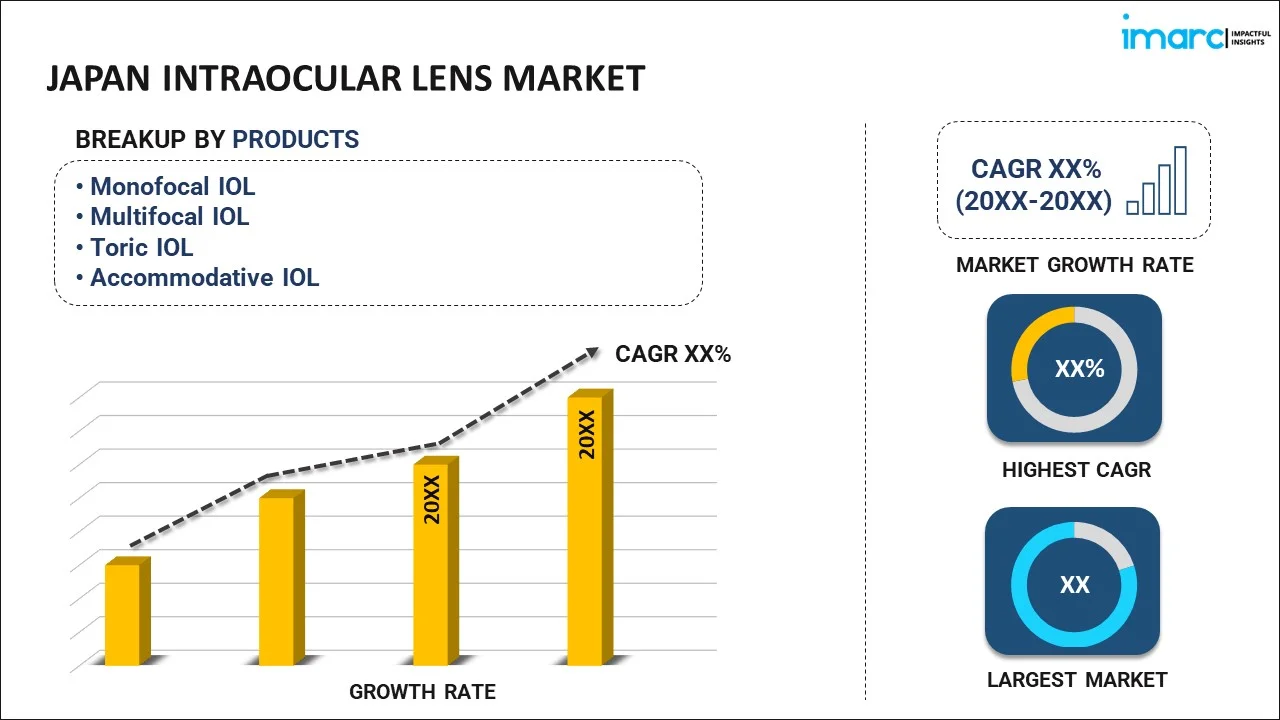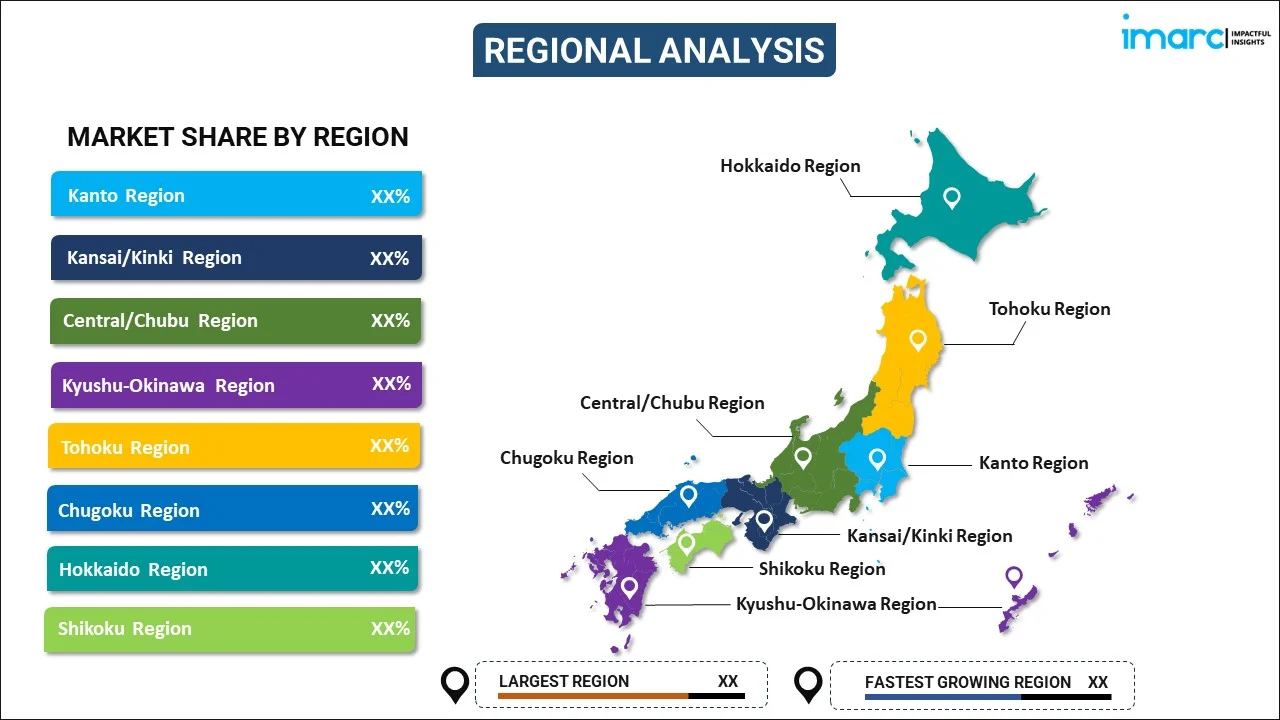
Japan Intraocular Lens Market Report by Product (Monofocal IOL, Multifocal IOL, Toric IOL, Accommodative IOL), Material (Polymethylmethacrylate (PMMA), Silicone, Hydrophobic Acrylic), End Use (Hospitals, Ophthalmic Clinics, Ambulatory Care Centers, Eye Research Institutes), and Region 2025-2033
Market Overview:
Japan intraocular lens market size reached USD 201.1 Million in 2024. Looking forward, IMARC Group expects the market to reach USD 317.3 Million by 2033, exhibiting a growth rate (CAGR) of 4.7% during 2025-2033. Various health reimbursements offered by government bodies for eye examinations, along with the inflating popularity of trifocal lenses that eliminate the need for spectacles, are primarily driving the market growth.
|
Report Attribute
|
Key Statistics
|
|---|---|
|
Base Year
|
2024 |
|
Forecast Years
|
2025-2033
|
|
Historical Years
|
2019-2024
|
| Market Size in 2024 | USD 201.1 Million |
| Market Forecast in 2033 | USD 317.3 Million |
| Market Growth Rate (2025-2033) | 4.7% |
An intraocular lens (IOL) is a medical implant employed to substitute the focusing capability of the natural lens extracted during cataract surgery or used in vision correction procedures like refractive lens exchange. Typically crafted from materials such as silicone, acrylic, and various plastic compositions, IOLs are additionally coated with a special material designed to shield the eyes from harmful ultraviolet (UV) rays. Currently, numerous manufacturers provide a diverse range of premium intraocular lens products with varying focusing capacities tailored to the individual's axial eye length and corneal curvature.
Japan Intraocular Lens Market Trends:
In the context of the Japanese market, several key factors are propelling the growth of the intraocular lens (IOL) sector. Foremost, the market is significantly influenced by the expanding elderly population on a wide scale. With the increasing occurrences of cataracts in the elderly and diabetic patients, there has been a notable surge in demand for intraocular lenses. This growing demand is further supported by government initiatives in numerous countries, including Japan, aimed at raising awareness about preventable blindness. Moreover, these initiatives include organizing cost-free eye examination and surgery camps, as well as providing healthcare reimbursements, which is acting as another significant growth-inducing factor. These efforts contribute to a positive market outlook. Furthermore, the market is driven by the introduction of premium intraocular lenses, such as multifocal and accommodative lenses, which offer enhanced precision, multifocal capabilities, and improved visual outcomes for patients. Several industry players are also investing in research and development (R&D) endeavors to introduce product variants anticipated to benefit patients with both near and distant vision. Additional factors contributing to market growth encompass the increasing healthcare spending capacity among consumers and a growing incidence of pediatric cataract cases. These elements collectively will contribute to the expansion of the intraocular lens market in Japan over the forecasted period.
Japan Intraocular Lens Market Segmentation:
IMARC Group provides an analysis of the key trends in each segment of the market, along with forecasts at the country level for 2025-2033. Our report has categorized the market based on product, material, and end use.
Product Insights:

- Monofocal IOL
- Multifocal IOL
- Toric IOL
- Accommodative IOL
The report has provided a detailed breakup and analysis of the market based on the product. This includes monofocal IOL, multifocal IOL, toric IOL, and accommodative IOL.
Material Insights:
- Polymethylmethacrylate (PMMA)
- Silicone
- Hydrophobic Acrylic
A detailed breakup and analysis of the market based on the material have also been provided in the report. This includes polymethylmethacrylate (PMMA), silicone, and hydrophobic acrylic.
End Use Insights:
- Hospitals
- Ophthalmic Clinics
- Ambulatory Care Centers
- Eye Research Institutes
The report has provided a detailed breakup and analysis of the market based on the end use. This includes hospitals, ophthalmic clinics, ambulatory care centers, and eye research institutes.
Regional Insights:

- Kanto Region
- Kansai/Kinki Region
- Central/ Chubu Region
- Kyushu-Okinawa Region
- Tohoku Region
- Chugoku Region
- Hokkaido Region
- Shikoku Region
The report has also provided a comprehensive analysis of all the major regional markets, which include Kanto Region, Kansai/Kinki Region, Central/ Chubu Region, Kyushu-Okinawa Region, Tohoku Region, Chugoku Region, Hokkaido Region, and Shikoku Region.
Competitive Landscape:
The market research report has also provided a comprehensive analysis of the competitive landscape. Competitive analysis such as market structure, key player positioning, top winning strategies, competitive dashboard, and company evaluation quadrant has been covered in the report. Also, detailed profiles of all major companies have been provided.
Japan Intraocular Lens Market Report Coverage:
| Report Features | Details |
|---|---|
| Base Year of the Analysis | 2024 |
| Historical Period | 2019-2024 |
| Forecast Period | 2025-2033 |
| Units | Million USD |
| Scope of the Report | Exploration of Historical and Forecast Trends, Industry Catalysts and Challenges, Segment-Wise Historical and Predictive Market Assessment:
|
| Products Covered | Monofocal IOL, Multifocal IOL, Toric IOL, Accommodative IOL |
| Materials Covered | Polymethylmethacrylate (PMMA), Silicone, Hydrophobic Acrylic |
| End Uses Covered | Hospitals, Ophthalmic Clinics, Ambulatory Care Centers, Eye Research Institutes |
| Regions Covered | Kanto Region, Kansai/Kinki Region, Central/ Chubu Region, Kyushu-Okinawa Region, Tohoku Region, Chugoku Region, Hokkaido Region, Shikoku Region |
| Customization Scope | 10% Free Customization |
| Post-Sale Analyst Support | 10-12 Weeks |
| Delivery Format | PDF and Excel through Email (We can also provide the editable version of the report in PPT/Word format on special request) |
Key Questions Answered in This Report:
- How has the Japan intraocular lens market performed so far and how will it perform in the coming years?
- What has been the impact of COVID-19 on the Japan intraocular lens market?
- What is the breakup of the Japan intraocular lens market on the basis of product?
- What is the breakup of the Japan intraocular lens market on the basis of material?
- What is the breakup of the Japan intraocular lens market on the basis of end use?
- What are the various stages in the value chain of the Japan intraocular lens market?
- What are the key driving factors and challenges in the Japan intraocular lens?
- What is the structure of the Japan intraocular lens market and who are the key players?
- What is the degree of competition in the Japan intraocular lens market?
Key Benefits for Stakeholders:
- IMARC’s industry report offers a comprehensive quantitative analysis of various market segments, historical and current market trends, market forecasts, and dynamics of the Japan intraocular lens market from 2019-2033.
- The research report provides the latest information on the market drivers, challenges, and opportunities in the Japan intraocular lens market.
- Porter's five forces analysis assist stakeholders in assessing the impact of new entrants, competitive rivalry, supplier power, buyer power, and the threat of substitution. It helps stakeholders to analyze the level of competition within the Japan intraocular lens industry and its attractiveness.
- Competitive landscape allows stakeholders to understand their competitive environment and provides an insight into the current positions of key players in the market.
Need more help?
- Speak to our experienced analysts for insights on the current market scenarios.
- Include additional segments and countries to customize the report as per your requirement.
- Gain an unparalleled competitive advantage in your domain by understanding how to utilize the report and positively impacting your operations and revenue.
- For further assistance, please connect with our analysts.
 Inquire Before Buying
Inquire Before Buying
 Speak to an Analyst
Speak to an Analyst
 Request Brochure
Request Brochure
 Request Customization
Request Customization




.webp)




.webp)












